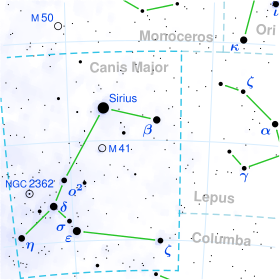HR 2583
| Observation data Epoch J2000.0 Equinox J2000.0 (ICRS) |
|
|---|---|
| Constellation | Canis Major |
| Right ascension | 06h 54m 13.04410s |
| Declination | −23° 55′ 42.0150″ |
| Apparent magnitude (V) | 6.91 6.71 to 6.95 |
| Characteristics | |
| Spectral type | WN4-s |
| U−B color index | −0.89 |
| B−V color index | −0.28 |
| Variable type | UGZ? |
| Astrometry | |
| Proper motion (μ) |
RA: −3.76 mas/yr Dec.: 4.35 mas/yr |
| Parallax (π) | 1.17 ± 0.57mas |
| Distance | 4,900 ly (1,500pc) |
| Absolute magnitude (MV) | −4.85 |
| Details | |
| Mass | 19 M☉ |
| Radius | 2.65 R☉ |
| Luminosity (bolometric) | 400,000 L☉ |
| Temperature | 89,100 K |
| Other designations | |
| Database references | |
| SIMBAD | data |
EZ Canis Majoris (EZ CMa) is a Wolf-Rayet star in the constellation of Canis Major. It is one of the ten brightest Wolf-Rayet stars.
EZ CMa has an apparent visual magnitude which varies between 6.71 and 6.95 over a period of 3.766 days, along with changes in the spectrum. It has been proposed that it could be a binary star, with a neutron star as companion that would complete an orbit around the Wolf-Rayet with that period, being it the cause of those variations. The General Catalogue of Variable Stars lists it as a possible cataclysmic variable on this basis. However it seems more likely that companion does not exist and spectral variations are caused by activity on the star's surface.
The spectral type of WN4 indicates an extremely hot star, and this leads to a very high luminosity, mostly emitted as ultraviolet radiation. The spectrum shows a star entirely devoid of hydrogen at the surface.
EZ CMa is surrounded by a faint bubble nebula, a small HII region blown by stellar winds up to 1,700 km/s and ionised by the intense UV radiation. This is catalogued as Sharpless 308 or just S308. It is likely to be a member of the very scattered open cluster Collinder 121, found around the orange supergiant ο1 CMa.
...
Wikipedia

